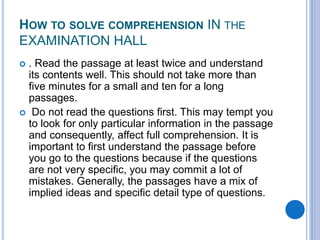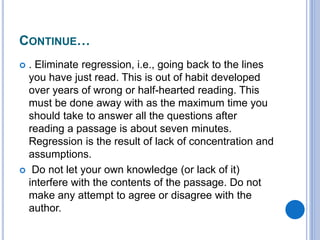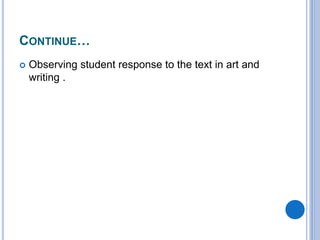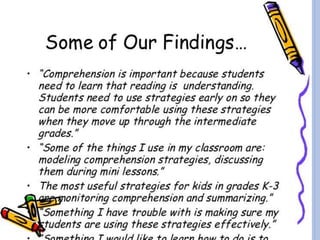COMPREHENION
- 3. CONTINUE… The ability to understand something. A comprehension exercise consists of a passage upon which questions are set to test the students ability to understand the content of the given text and to infer information and meanings from it.
- 4. RULES OF COMPREHENSION Read the passage fairly quickly to get the general idea. Read again , a little slowly , so as to know the details. Study the questions thoroughly . Turn to the relevant portions of the passage , read them again , and rewrite them in your own words , neatly and precisely .
- 5. CONTINUE… Use complete sentence If you are ask to give the meaning of any words or phrases , you should express the idea as clearly as possible in your own words . Certain words require the kind if definition that is given in a dictionary . Take care to frame the definition in conformity with the part of speech. Have a clear and logical thought process. Do not clutter your brain with unnecessary and irrelevant thoughts and details.
- 8. HOW TO SOLVE COMPREHENSION IN THE EXAMINATION HALL . Read the passage at least twice and understand its contents well. This should not take more than five minutes for a small and ten for a long passages. Do not read the questions first. This may tempt you to look for only particular information in the passage and consequently, affect full comprehension. It is important to first understand the passage before you go to the questions because if the questions are not very specific, you may commit a lot of mistakes. Generally, the passages have a mix of implied ideas and specific detail type of questions.
- 9. CONTINUE… . Eliminate regression, i.e., going back to the lines you have just read. This is out of habit developed over years of wrong or half-hearted reading. This must be done away with as the maximum time you should take to answer all the questions after reading a passage is about seven minutes. Regression is the result of lack of concentration and assumptions. Do not let your own knowledge (or lack of it) interfere with the contents of the passage. Do not make any attempt to agree or disagree with the author.
- 10. CONTINUE… Your principal task in attempting a comprehension passage should comprise: i. Finding the topic. The topic must be precise. Generally the topic is found either in the first or in the last line. ii. Finding the main idea. This can be a definition, a classification, a purpose or an elaboration of the topic; often the topic and the main idea are the same. iii. Finding major supporting details. The supporting details modify, explain or elaborate the main idea. You should learn to recognize these supporting details that explain, illustrate, compare and contrast, show cause- effect relationship or merely restate the main idea in other words.
- 11. CONTINUE… Underline the words you don’t know the meaning of. Try to relate them to the given context. Resort to sentence analysis and break a sentence into parts, looking for answers to who, what, whom, when, where, which, why and how. Locate reference words and check what they refer to. Underline signal words and look for what they indicate. . If the passage contains more than one paragraph, resort to paragraph analysis in the manner given above (5 to 10).
- 12. INFORMAL ASSESSMENT IN CLASS Asking students if they understand a story or an information piece. Having conversation with the students about the material read. Observing students as they response to text verbally and non-verbally. Observing student behavior for evidence for using clues while reading .
- 13. CONTINUE… Observing student response to the text in art and writing .
- 14. TYPES OF COMPREHENSION STRATEGIES There are six main types of comprehension strategies . Make Connections—Readers connect the topic or information to what they already know about themselves, about other texts, and about the world. Ask Questions—Readers ask themselves questions about the text, their reactions to it, and the author's purpose for writing it.
- 15. CONTINUE… Visualize—Readers make the printed word real and concrete by creating a “movie” of the text in their minds. Determine Text Importance—Readers distinguish between what's essential versus what's interesting, distinguish between fact and opinion, determine cause-and-effect relationships, compare and contrast ideas or information,
- 16. CONTINUE…. discern themes, opinions, or perspectives, pinpoint problems and solutions name steps in a process, locate information that answers specific questions, summarize.
- 17. CONTINUE… Make Inferences—Readers merge text clues with their prior knowledge and determine answers to questions that lead to conclusions about underlying themes or ideas. Synthesize—Readers combine new information with existing knowledge to form original ideas, new lines of thinking, or new creations.
- 20. THE ROLE OF COMPREHENSION INSTRUCTION Teachers can play a critical role in helping students develop their comprehension skills. Reading research has shown that comprehension instruction can help students do a better job of understanding and remembering what they read. Good instruction can also help students communicate with others, verbally and in writing, about what they’ve read.
- 21. COMPREHENSION IS EVEN MORE IMPORTANT TODAY Comprehension is an essential part of successfully developing 21st century literacies. It is a vital tool for reading in our modern age, a vehicle through which we: gain meaning from the words someone else has constructed, learn something new, to confirm something we think,
- 22. CONTINUE…. understand another’s viewpoint, to relax and, yes, even to escape from the everyday pressures of life. A student can do all those things well and still not understand what the words mean.
- 23. CONTINUE… What value is there in that? Whether you teach reading in the classroom or work with your own children at home, be careful that you always define reading, not by the subskills involved, but by the understanding gained. 4
- 24. CAUSES OF READING COMPREHENSION FAILURE Inadequate instruction Insufficient exposure and practice Deficient word recognition skills Deficient memory capacity and functioning Significant language deficiencies Inadequate comprehension monitoring and self- evaluation
- 25. CONTINUE… Unfamiliarity with text features and task demands Undeveloped attentional strategies Inadequate cognitive development and reading experiences
- 27. THANK YOU
Editor's Notes
- #13: E he


























